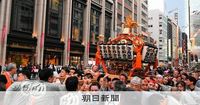The Kanda Matsuri's Shinkosai, where a large procession including mikoshi and yamaguruma parades through central Tokyo, took place on May 10, 2025. This biannual event, one of the three major festivals of Edo, saw a lavish display of traditional floats and portable shrines making their way through key districts such as Otemachi, Nihonbashi, and Akihabara, covering approximately 30 kilometers.
At the heart of the festivities was Takata Fujii, the vice chairman of the Yakuso Jinja Hokenkai and the ujiko sotaicho of Kanda Myojin, who welcomed the procession at Nihonbashi Muromachi in Chuo Ward. Fujii, who is also the president of the pharmaceutical company Ryukakusan based in Chiyoda Ward, performed the 'Kensen' ritual, a ceremonial offering of food to the deities, representing the Yakuso Jinja Hokenkai. This ritual is a longstanding tradition at the Kanda Matsuri, emphasizing the festival's deep cultural roots.
Fujii expressed the importance of the day's activities, stating, "Maintaining health using household medicines amid the aging population and rising medical costs will lead to controlling medical expenses." This statement highlights the festival's dual purpose: to celebrate cultural heritage while also promoting health management through the responsible use of over-the-counter medicines.
The procession featured three central floats, known as horen, alongside numerous mikoshi, which are portable shrines carried by festival participants. The event also included a merging with the 'Tsuke Matsuri' at the Mitsukoshi Nihonbashi Main Store, where floats and costumed processions with themes like Daikokuten and Ebisu added to the festive atmosphere. Thousands of participants and spectators flocked to the streets, creating a vibrant scene filled with excitement and cultural pride.
Among the attendees was 23-year-old Nao Igarashi from Suginami Ward, who visited the festival with her mother. She remarked, "There are so many different mikoshi; it's amazing!" Her enthusiasm reflects the joy and wonder many feel when experiencing such a rich cultural event. Additionally, German tourist Marie-Christine Heinrich, 26, discovered the Shinkosai while near the Imperial Palace. "I was drawn in by the sounds of the taiko drums and applause. I'm so glad I got to see a Japanese festival!" she exclaimed, highlighting the event's international appeal.
The Kanda Matsuri is not just a local celebration; it attracts visitors from all over the world, showcasing Japan's rich cultural tapestry. The festival continues with events planned for May 11, when over 200 mikoshi will parade through the streets of Kanda, culminating in the 'Mikoshi Miyairi' at Kanda Myojin. This marks a significant moment in the festival, as the mikoshi are brought into the shrine, symbolizing the connection between the divine and the community.
As the Kanda Matsuri unfolds, it serves as a reminder of the importance of tradition in modern society. In a time when many are turning to digital and fast-paced lifestyles, events like the Kanda Matsuri offer a chance to reconnect with cultural heritage and community values. The festival runs until the Reitaisai on May 15, 2025, ensuring that the spirit of the Kanda Matsuri continues to thrive and resonate with both locals and visitors alike.


